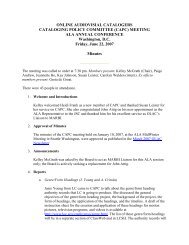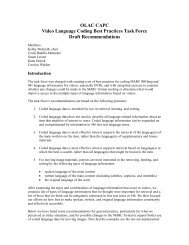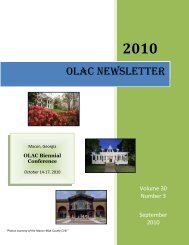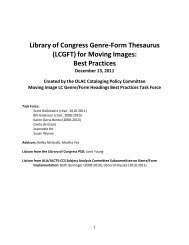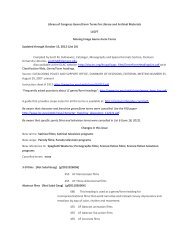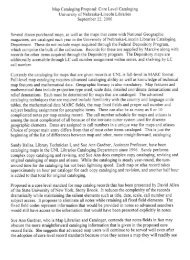see workshop handouts - OLAC
see workshop handouts - OLAC
see workshop handouts - OLAC
You also want an ePaper? Increase the reach of your titles
YUMPU automatically turns print PDFs into web optimized ePapers that Google loves.
General Drafting Date Codes<br />
General Drafting has not used a date code in the sense of Rand<br />
or Gousha. If any problem exists with GD it is that they use too many<br />
dates! The exception is some maps from the 1920's are completely<br />
undated and can only be dated by comparing with maps of known date.<br />
If a date is shown on the cover or in the legend, then that is<br />
the date to use. When two dates are given, such as 1955-1956 or<br />
1970-71, then always use the first year. Many maps also have a<br />
copyright date which is frequently one year earlier than the legend<br />
date, in this case use the legend date. However, if the copyright<br />
date is the only date, there is no other date in the legend, then use<br />
the copyright date (this is particularly true since 19791.<br />
In the 1960's, the legend frequently contained a month in<br />
addition to the year. In these cases, for January through august,<br />
use the year given; but for September through December, use the next<br />
year. This is basically the system GD uses and it will result in<br />
common cover designs being called the same year. (This applies to the<br />
years 1962 - 1966 in the detailed map listings.).<br />
Due to reprintings, it is possible for the same map to exist as<br />
1970 and 1970-71, and similarly for other years. These are not<br />
listed as separate dates but, in this example, only as 1970.<br />
Since the 1940's, most GD maps contain three or four small<br />
digits plus a letter in the margin or on the back cover. This is the<br />
month and year of'printing and should not be used to dafe the map<br />
unless nothing else exists. These change for each reprinting. The<br />
letter indicates the printing company. The only one known for sure is<br />
W for Western Publishing and Printing Co.<br />
fill of the above explains how to determine the date on which the<br />
map was issued. But since about 1958, GD has used a code to date the<br />
masters from which the map was created. This date is coded as a<br />
small-A' plus a number in a bottom corner of a map. Th i s number<br />
indicates the year the base map was first drafted. It is not updated<br />
unless the base is redrawn. Al was for 1953. The following table is<br />
for quick reference, but IS NOT THE DATE THE MAP WAS ISSUED.’<br />
Al - 1953 A7 - 1959<br />
A2 - 1954 A8 - 1960<br />
A3 - 1955 A9 - 1961<br />
A4 - 1956 Al0 - 1962<br />
A5 - 1957 All 4 1963<br />
A6 - 1958 Al2 - 1964<br />
Al3 - 1965 Al9 - 1971 A25 - 1977<br />
Al4 - 1966 A20 - 1972 A26 - 1978<br />
Al5 - 1967 A21 - 1973 A27 - 1979<br />
Al6 - 1968 A22 - 1974 A28 - 1980<br />
Al7 - 1969 A23 - 1975 A29 - 1981<br />
Al8 - 1970 A24 - 1976 A30 - 1982<br />
Geographers A-Z Hap Company (Code Is located in or near<br />
the border at one corner of maps. Atlases are coded<br />
differently. Send a photocopy of the title page to the<br />
company and they will provide accurate dates).<br />
J I H G F E D C B A<br />
1 . 2 3 4 5 6 7 8 9 0<br />
“FDC” is “578” or May, 1978.<br />
Information courtesy of Peter L. Stark,<br />
with additions from Mark A. Bozanich, and Velma Parker.



